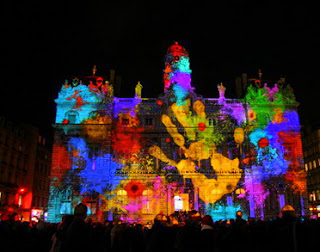Lyon, France is a city dear to my heart, the setting of my first novel. Each December, Lyon stages a spectacular Festival of Lights that draws visitors from all over France and Europe. This year, the festival runs from December 6th-9th. Here to tell us about the festival and its history is historical fiction author Liza Perrat, who lives in a small town on the outskirts of Lyon and whose novel, SPIRIT OF LOST ANGELS, I will be reviewing at the end of the week.
The Black Death Illuminated
by Liza Perrat
"Protect us from famine, war and plague, Seigneur," cried the Lyonnaise people in 1628. Alas, their pleas came too late--the bubonic plague had already crossed the Rhône River, terrifying the inhabitants and killing half of them.
The desperate people prayed to the Virgin Mary to return good health to the city until miraculously, in 1643, the plague disappeared and the Lyonnaise people never doubted their divine protection. So, how did this episode of divine intervention become the largest modern-day international light festival?
Over a century later, in the 1980s, in conjunction with the advent of the lighting plan, the city of Lyon decided to transform the December 8 festival into the Fête des Lumières (light festival). On the eve of the winter solstice, in a magnificent urban ritual, the city's public places would be illuminated in a different way each year.
Residents, associations, cultural groups, humanitarian associations and the local government work with artists, musical and theatrical performers, photographers and lighting engineers to provide the colored symphony of light that bathes the city in today's celebration of light.
The festival, which attracts over four million visitors to Lyon, includes other light-based activities and lasts four days, with the main events occurring on the 8th. The focal points are generally the Fourvière Basilica, Saint Jean Cathedral, and the Place des Terreaux, where music, dancing, parades and food stalls transform the old district of Lyon into a place flooded with light, beauty and sound.
photo credit: mondoramas
I began attending the festival back in 2002. Crossing the Saône River, my first glimpse of the illuminations was the Fourvière Basilica, overlooking the city on Fourvière hill. Symbolic of the people's devotion to the Virgin Mary, the basilica was constructed between 1872 and 1884. Its oriental and neo-classic columns and columned porticos, blended with mediaeval-style machicolated towers, were lit in spectacularly fluorescent shades of green, blue and violet.
On Place des Terreaux, the ancient stones faded beneath a cinematic screen of stars and moons. Colored lights and shapes danced on the stages of renaissance architecture, and, as a bloodied revolutionary soldier crept across the starry sky, I lost all sense of dimension.
"December 8 has always been a show of thousands of people strolling together on a winter night in a city transformed simply by their presence," said one of the artistic directors. "This moving public is at the heart of the festival, just as it is at the heart of urbanity, each person being a vector of light within the nocturnal landscape."
Since its origin in the nineteenth century, December 8 has taken on an undeniably futuristic allure. But despite the magnificent illuminations, it seems that for the Lyonnaise people, the soul of the light festival remains within the beauty of thousands of tiny candle flames burning in unison along their windowsills. As people come from all over the world to share the rejoicing and emotion of these four breathtaking nights, the Lyonnaise people, lovers of tradition, continue, to pay homage to the Virgin Mary for banishing the Black Death from their midst.
For more information and stunning photos, please refer to the festival's official website.
**********
Liza grew up in Wollongong, Australia, where she worked as a general nurse and midwife for fifteen years. When she met her French husband on a Bangkok bus, she moved to France, where she has been living for twenty years. She works part-time as a French-English medical translator.
Since she completed a creative writing course ten years ago, several of her short stories have won awards, notably the Writers Bureau annual competition of 2004 and her stories have been published widely in anthologies and small press magazines. Her articles on French culture and tradition have been published in international magazines such as France Magazine and France Today.
She has completed four novels and one short-story collection, and is represented by Judith Murdoch of the Judith Murdoch Literary Agency.
SPIRIT OF LOST ANGELS, published in May 2012 under the Triskele Books label, is the first in a historical series set against a backdrop of rural France. Her agent is currently trying to sell the second in the series, WOLFSANGEL, and Liza is working on the third story, ANGEL OF ROSES, set in the 14th century plague years of France.
For more information on Liza or her books, please refer to her website or blog.




.JPG)













No comments:
Post a Comment